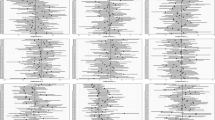Abstract
The high prevalence of spurious solutions and the disturbing effect of outlying observations in mixture modeling are well known problems that pose serious difficulties for non-expert practitioners of this kind of models in different applied areas. An approach which combines the use of Trimmed Maximum Likelihood ideas and the imposition of restrictions on the maximization problem will be presented and studied in this paper. The proposed methodology is shown to have nice mathematical properties as well as good performance in avoiding the appearance of spurious solutions in a quite automatic manner.



Similar content being viewed by others
References
Calò DG (2008) Mixture Models in Forward Search Methods for Outlier Detection. In: Preisach C, Burkhardt H, Schmidt-Thieme L, Decker R (eds) Studies in Classification, Data Analysis, and Knowledge Organization. Springer, Berlin, pp 103–110
Coretto P, Hennig C (2010) A simulations study to compare robust clustering methods based on mixtures. Adv. Data. Anal. Classif. 4:111–135
Fraley C, Raftery AE (1998) How many clusters? Which clustering method? Answers via model-based cluster analysis. Comput. J. 41:578–588
Fritz H, García-Escudero LA, Mayo-Iscar A (2013) A fast algorithm for robust constrained clustering. Comput. Stat. Data Anal. 61:124–136
Gallegos MT, Ritter G (2009) Trimmed ML estimation of contaminated mixtures. Sankhya (Ser. A) 71:164–220
García-Escudero LA, Gordaliza A, Matrán C, Mayo-Iscar A (2008) A general trimming approach to robust cluster analysis. Ann. Stat. 36:1324–1345
García-Escudero LA, Gordaliza A, Matrn C, Mayo-Iscar A (2011) Exploring the number of groups in robust model-based clustering. Stat. Comput. 21:585–599
García-Escudero, L.A., Gordaliza, A., Matrán, C., Mayo-Iscar, A.: Avoiding spurious local maximizers in mixture modelling. (2013) (preprint). http://www.eio.uva.es/infor/personas/slm2_web.pdf
Hubert L, Arabie P (1985) Comparing partitions. J. Classif. 2:193218
Ingrassia S, Rocci R (2007) Constrained monotone EM algorithms for finite mixture of multivariate Gaussians. Comput. Stat. Data Anal. 51:5339–5351
McLachlan G, Peel D (2000) Finite Mixture Models. Wiley, New York
Neykov N, Filzmoser P, Dimova R, Neytchev P (2007) Robust fitting of mixtures using the trimmed likelihood estimator. Comput. Stat. Data. Anal. 17:299–308
van der Vaart AW, Wellner JA (1996) Weak Convergence and Empirical Processes. Wiley, New York
Acknowledgments
We would like to thank the reviewers and the associate editor for insightful comments and constructive suggestions, that have contributed to improve the manuscript.
Author information
Authors and Affiliations
Corresponding author
Additional information
This research is partially supported by the Spanish Ministerio de Ciencia e Innovación, grant MTM2011-28657-C02-01.
Rights and permissions
About this article
Cite this article
García-Escudero, L.A., Gordaliza, A. & Mayo-Iscar, A. A constrained robust proposal for mixture modeling avoiding spurious solutions. Adv Data Anal Classif 8, 27–43 (2014). https://doi.org/10.1007/s11634-013-0153-3
Received:
Revised:
Accepted:
Published:
Issue Date:
DOI: https://doi.org/10.1007/s11634-013-0153-3




